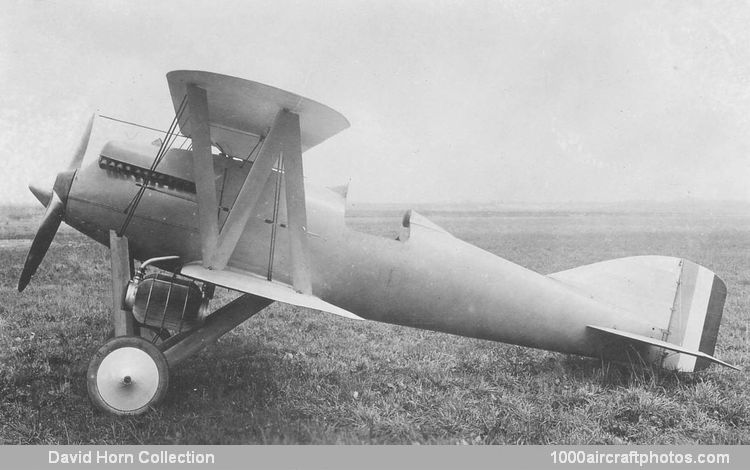12/15/2015. Remarks by Johan Visschedijk: "In 1921, the US Navy decided to compete for the Pulitzer Trophy Race, which had been won by the Army in 1920 with a hotted-up experimental fighter. Curtiss, the only major US manufacturer with previous experience in unlimited racer design, was given a contract for two new racers on June 16, 1921. In the absence of a Naval aircraft designation system at the time, these aeroplanes were identified simply as Curtiss Racer No. 1 and Curtiss Racer No. 2. The Curtiss Garden City plant where they were designed and built gave them the engineering numbers L-17-1 and L-17-2, but in early released photographs they were identified only as CR. In 1922, the new Naval designation system identified the pair as CR-1 and CR-2; C-for-Curtiss, R-for-Racer, and -1 and -2 for two slightly different configurations.
The CRs, designed by Mike Thurston and Henry Routh, drew heavily on the design of the Cox racers, but used more conventional biplane wings with a proven Sloan airfoil section. The engines used were special 425 hp direct-drive developments of the 1920 Curtiss C-12 known as the CD-12 that operated on a mixture of 50% Benzol and 50% gasoline. As on the Cox machines, the nose contours were uninterrupted by radiators; novel French Lamblin units were fitted inside each pair of landing gear struts.
The pilots sat in conventional open cockpits of which the size of the opening had been reduced by the addition of a 'horsecollar' coaming fitted in place after the pilot was seated. Further drag reduction was achieved by the use of streamlined flying wires; wing N-struts cross-laminated from wood produced a single unit without the traditional drag-producing end fittings.
The first CR, Navy serial number A-6080, became the CR-1 but the designation was not official until March 1922. With plenty of time until the race, scheduled for November, both CRs were tested and tuned to perfection. Shortly before the race, however, both the Army and the Navy withdrew their entries so the first CR was not raced in 1921.
In 1922, the Navy was back in racing along with the Army. The CR-1 was test flown in its 1921 configuration, with such minor refinements as streamlined wheels and slightly larger tail surf aces added before the races, but was converted to CR-2 configuration with new wing skin radiators by race time. Flown by Navy pilot Lt Alford J. Williams (Racing No. 8), it came in fourth behind the two new Army Curtiss R-6 racers and the CR-2 at 188.8 mph (303.83 kmh). The CR-1 was converted to CR-3 in 1923.
The second CR, Navy serial number A-6081, was completed before the first. With no external designation or serial number applied, it could be distinguished from its sister only by the shape of the removable metal cowling on top of the nose. On CR-2 (pictured above) the bottom and rear of the cowling formed a right angle; on CR-1 the bottom of the cowling formed a smooth curve from the center line at the propeller to the top of the fuselage, visible in this photo of the A-6080 with Curtiss pilot Bert Acosta, who test flew the aircraft on August 1, 1921. All went well until the landing; an unseen depression during the landing run stood the racer on its nose but with only slight damage.
After the Navy withdrew from the 1921 race, Curtiss arranged to borrow the second CR and race it as a Curtiss entry with Acosta as the pilot. With the Army out of the race too, Acosta's only serious competition was the Curtiss-Cox triplane. Using Racing No. 4, he won easily at a speed of 176.7 mph (284.36 kmh), a new closed-course record, even though holding back because of a broken flying wire. On November 19, 1921, Acosta flew the same machine at 197.8 mph (318.32 kmh) to exceed the known world's record of 194.53 mph (313.06 kmh). It was not known at the time that France had just raised the record to 205.24 mph (330.29 kmh).
The Navy had Curtiss modify the second CR for the 1922 races and the CR-2 designation became official. The major change was to replace the Lamblin radiators with new Curtiss developed wing-surface radiators fitted to each of the upper wings. Other refinements were an increase in vertical tail area and the installation of streamlined wheels as on the CR-1. Flown by Lt H.J. Brow, the CR-2 (Racing No. 40) was placed third in the 1922 Pulitzer behind the Army's two new Curtiss R-6s at a speed of 193.2 mph (310.92 kmh).
In 1923, the Navy had Curtiss convert both CRs to CR-3 seaplanes (Model 23A, L-17-3) for the Schneider Trophy Race to be held in England. New Curtiss D-12 engines boosted to 475 hp at 2,300 rpm were installed and the vertical tail area was increased again. A significant change was replacement of the original wooden propellers with new forged aluminum Curtiss-Reed propellers that allowed higher engine speeds. Piloted by Lt David Rittenhouse, CR-3 A-608l (Racing No. 4) won at 177.4 mph (285.49 kmh), a new closed-course record, and A-6080 (Racing No. 3) piloted by Lt Paul Irvin came second at 173.5 mph (279.21 kmh).
All European entries withdrew from the 1924 Schneider, to be held in the United States. Rather than win by default, the United States cancelled the race but set up a series of record attempts during which Lt G.T. Cuddihy in CR-3 A-6081 set a new world's closed-course seaplane speed record of 188.07 mph (302.66 km/h).
Not raced in 1925, A-6081 was used as a test bed and as a trainer for the 1926 racing teams under the designation of CR-4."
